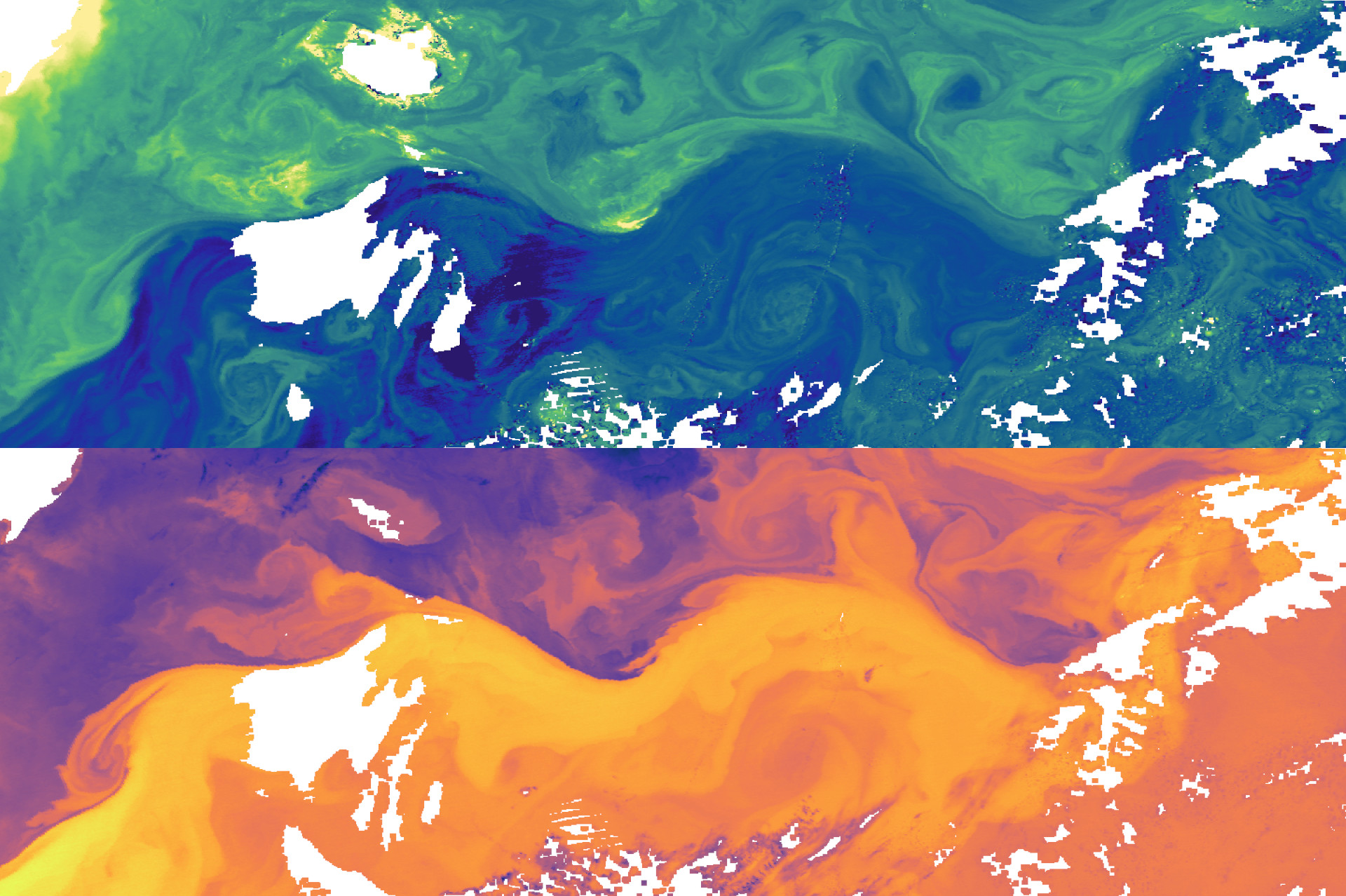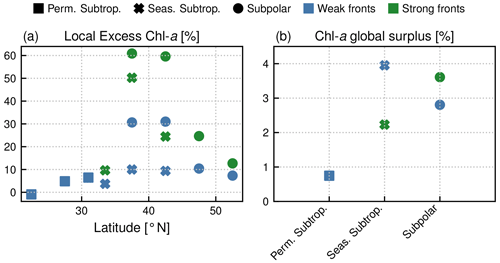My Work #
Studies over the past two decades seem to indicate that ocean currents at small scales (of order of magnitudes between 1km and 10km) have a strong influence on phytoplankton. However, precisely quantifying their impact on the ecosystem as a whole – that is, on regions typically spanning thousands of kilometers – is challenging.
PhD #
During my thesis, I attempted to quantify the impact of fronts (key structures at small scales) on phytoplankton in a large area around the Gulf Stream, using satellite imagery.

Gulf Stream meanders from space: Chlorophyll-a (top) and SST (bottom). MODIS-Aqua L2 data, 2007-04-22.
We detected fronts by computing an Heterogeneity Index from satelltie sea surface temperature (Haëck et al. 20231, Liu & Levine 20162).
We then quantified the chlorophyll (also from satellite data) inside and outside these fronts. This work was made challenging by the presence of regions with different biogeochemical regimes and large-scale gradients within these regions. We show the importance of distinguishing the impact of fronts measured locally, and regionally by taking the impacted surface into account. We observe that the impact of fronts depends on their intensity. Lastly we were able to measure an earlier bloom onset with the fronts, by one to two weeks.

These findings are presented in the article “Satellite data reveal earlier and stronger phytoplankton blooms over fronts in the Gulf Stream region”, as well as in my PhD manuscript (in french).
Current #
I am continuing to work on refining the methodology that I established during my PhD. We have since applied it to data of phytoplankton composition generated by Roy El Hourany3 (in review4). It has also been applied in the California Current region5, with the aim (amongst other) of extending the results above to other areas. As part of the 4DMED-Sea project, this methodology will be applied to the mediterranean sea. Several avenues of study are also being considered: decadal trends, the influence some methodological parameters (beyond those already tested),…
Even if the code used is already publicly available (gitlab.in2p3.fr/clementhaeck/submeso-color), I am currently working to make them more accessible and easily reusable, splitting them into two separate projects: heterogeneity-index and data-assistant. Their application at a global scale is in development at gitlab.in2p3.fr/biofronts/submeso-color
Haëck C., Lévy M., Mangolte I., Bopp L. “Satellite Data Reveal Earlier and Stronger Phytoplankton Blooms over Fronts in the Gulf Stream Region”. Biogeosciences 20.9 (may 2023). doi:10.5194/bg-20-1741-2023 ↩︎
Liu X., Levine N. M. “Enhancement of Phytoplankton Chlorophyll by Submesoscale Frontal Dynamics in the North Pacific Subtropical Gyre”. Geophys. Res. Lett. 43.4 (2016). doi:10.1002/2015gl066996 ↩︎
El Hourany R., Abboud‐Abi Saab M., Faour G., Aumont O., Crépon M., Thiria S. “Estimation of Secondary Phytoplankton Pigments from Satellite Observations Using Self-Organizing Maps (SOMs)”. J. Geophys. Res. Oceans 124.2 (feb. 2019), p. 1357-1378. doi:10.1029/2018jc014450 ↩︎
Lévy M., Haëck C., Mangolte I., Cassianides A., El Hourany R. “Satellite data reveal fine-scale dissimilarities in phytoplankton assemblage” [pre-print]. ESS Open Archive (jul. 2024). url: https://www.authorea.com/users/664528/articles/1213829-satellite-data-reveal-fine-scale-dissimilarities-in-phytoplankton-assemblage# ↩︎
Mangolte I., Lévy M., Haëck C., Ohman M.D. “Sub-frontal niches of plankton communities driven by transport and trophic interactions at ocean fronts”. Biogeosciences 20.15, (aug. 2023). doi:10.5194/bg-20-3273-2023 ↩︎